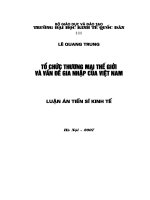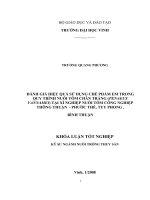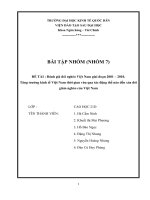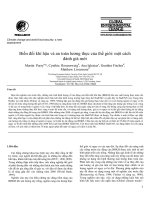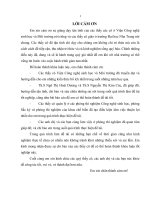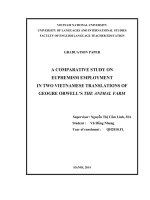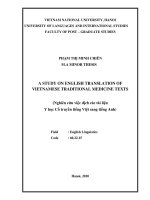evaluating the english version of the novel beloved oxford , đánh giá bản dịch việt - anh tác phẩm oxford thương yêu
Bạn đang xem bản rút gọn của tài liệu. Xem và tải ngay bản đầy đủ của tài liệu tại đây (906.48 KB, 62 trang )
VIETNAM NATIONAL UNIVERSITY, HA NOI
UNIVERSITY OF LANGUAGES AND INTERNATIONAL STUDIES
FACULTY OF POST - GRADUATE STUDIES
***
TRẦN THANH HƯƠNG
EVALUATING THE ENGLISH VERSION OF THE
NOVEL “BELOVED OXFORD”
(Đánh giá bản dịch Việt – Anh tác phẩm “Oxford thương yêu”)
M.A MINOR THESIS
Field: English Linguistics
Code: 60 22 15
Hanoi - 2012
VIETNAM NATIONAL UNIVERSITY, HA NOI
UNIVERSITY OF LANGUAGES & INTERNATIONAL STUDIES
FACULTY OF POST- GRADUATE STUDIES
***
TRẦN THANH HƯƠNG
EVALUATING THE ENGLISH VERSION OF THE
NOVEL “BELOVED OXFORD”
(Đánh giá bản dịch Việt – Anh tác phẩm “Oxford thương yêu”)
M.A MINOR THESIS
Field: English Linguistics
Code: 60 22 15
Supervisor: Assoc.Prof.Dr. LÊ HÙNG TIẾN
Hanoi - 2012
iv
TABLE OF CONTENTS
DECLARATION
i
ACKNOWLEDGEMENTS
ii
ABSTRACT
iii
TABLE OF CONTENTS
iv
LIST OF ABBREVIATIONS
vi
LIST OF TABLES
vii
PART 1: INTRODUCTION
01
1. Rationale of the study
01
2. Scope of the study
02
3. Aims of the study
02
4. Research methodology
02
5. Organization of the study
03
PART 2: DEVELOPMENT
04
CHAPTER 1: LITERATURE REVIEW
04
1.1. Literary translation
04
1.1.1. Literary translation definition
04
1.1.2. Characteristics of literary translation
04
1.1.3. Methods used in literary translation
06
1.1.4. Problems of literary translation
07
1.2. Translation quality assessment
09
1.2.1. Definition of translation quality assessment
09
1.2.2. Role of translation quality assessment
09
1.2.3. Models for translation quality assessment
10
v
CHAPTER 2: TRANSLATION QUALITY ASSESSMENT OF THE
ENGLISH VERSION OF THE NOVEL “BELOVED OXFORD”
14
2.1. Source text and the author
14
2.2. Translation and the translator
15
2.3. Translation quality assessment of the English version of Beloved
Oxford
16
2.3.1. Strengths
16
2.3.2. Weaknesses
18
2.3.2.1. Linguistic aspect
18
2.3.2.2. Translational aspect
19
2.3.3. Summary
37
PART 3: CONCLUSION
38
1. Recapitulation
38
2. Implications
38
3. Limitations and suggestion for further research
39
REFERENCES
40
APPENDICES
I
APPENDIX 1
I
APPENDIX 2
III
vi
LIST OF ABBREVIATIONS
OALD
Oxford Advanced Learner‟s Dictionary
SL
Source language
ST
Source text
TL
Target language
TQA
Translation quality assessment
TT
Target text
VD
Vietnamese Dictionary
vii
LIST OF TABLES
Table
Page
1
Examples of the strengths of the translation
16
2
Examples of word omission
19
3
Examples of addition
20
4
Examples of inappropriate equivalence at word level
22
5
Examples of inappropriate equivalence above word level
26
1
PART 1: INTRODUCTION
1. Rationale for the study
Translation has been of great importance to the world‟s society and culture,
especially in the current process of globalization. Thanks to translation, more and
more books, documents, news have been translated between languages, which
enables human access to the repository of knowledge of many fields in different
languages. It also contributes to the introduction of each country‟s identity to the
world. Therefore, international understanding, social cultural awareness among
people is dramatically improved.
Among translation fields, literary translation catches many people‟s interest.
A lot of foreign literature works have been translated into Vietnamese, and vice
versa. However, the question of how much the quality of literary translation is
remains unanswered. A plenty of translated versions have drawn much criticism
from reviewers and readers for the last few years. Thus, assessing the translations
becomes inevitable.
The novel Beloved Oxford written by Duong Thuy (published in 2007) is
chosen for several reasons. Firstly, it is one of the best sellers in its original
Vietnamese language in 2007. The novel has been reprinted seventeen times with
the total copies of 59,500 so far (up to April, 2012)
1
. Secondly, Beloved Oxford is
one of my favourite novels, which helps me understand more about the life of
Vietnamese students overseas. This novel is translated into English by Elbert
Bloom, an American reader, who is fascinated by Duong Thuy‟s works.
These reasons and interests provide me with motivation to work on this
thesis, “Evaluating the English version of the novel Beloved Oxford”.
1
From Retrieved May 20, 2012
2
2. Scope of the study
The beautiful romantic novel Beloved Oxford consists of sixteen chapters.
On the ground of limited time, conditions, this thesis focuses on the first three
chapters, namely The Surprising School Admission, The Challenger, The Lonely
Winter respectively. These chapters are selected because they help the readers
imagine the setting of the novel, the main characters‟ background and personalities;
and especially contain the typical strengths and weaknesses of the translation.
3. Aims of the study
The study is carried out to investigate the quality of the English version of
the novel Beloved Oxford based on Newmark‟s theory of translation criticism.
4. Research methodology
4.1. Research questions
In order to serve the aim of the study, two research questions are raised:
1. What are the strengths of the English version of Beloved Oxford in terms
of linguistic aspect and translational aspect?
2. What are the weaknesses of the English version of Beloved Oxford in
terms of linguistic aspect and translational aspect?
4.2. Research methods
To achieve the goal of the study, contrastive analysis is employed. The
researcher conducts the study in the following steps:
Building up a theoretical background for the study
3
Choosing an approach for TQA, that is Newmark‟s
Analyzing and comparing source text and target text to find out the
strengths and weaknesses of the translation in term of linguistic aspect
and translational aspect
5. Organization of the study
Part I is the Introduction which provides readers an overview of the thesis
including the rationale for the study, the aims, the scope, the methodology and the
organization of the study.
Part II is the Development, which includes two chapters.
Chapter 1 introduces the theoretical background knowledge related to literary
translation and TQA.
Chapter 2 is the main part of the study. It provides comparison and analysis
between original texts and translation texts, and discussion about the strengths and
weaknesses of the translation.
Part III is the Conclusion which summarizes the main ideas and findings of
the study, draws some implications for Vietnamese - English literary translations,
points out limitations of the study and makes suggestions for further research.
4
PART II: DEVELOPMENT
CHAPTER 1: LITERATURE REVIEW
1.1. Literary translation
1.1.1. Literary translation definition
Translation plays an important role in increasing awareness and
understanding among diverse cultures and nations. Literary translations in particular
help these different cultures reach a compromise. According to Toury (1995, cited
in Elkjær, 2010), a literary translation is a translation of a text deemed literary in the
source culture, which conforms - translates - to the requirements of a literary text in
the target culture. Therefore, in order for a translation to be a literary translation the
result of the translation must be acknowledged as literature in the target situation
and culture, thus bearing the target literature requirements upon it.
Having the same viewpoint, Schulte (2010) claims that “Literary translation
bridges the delicate emotional connections between cultures and languages and
furthers the understanding of human beings across national borders. In the act of
literary translation the soul of another culture becomes transparent, and the
translator recreates the refined sensibilities of foreign countries and their people
through the linguistic, musical, rhythmic, and visual possibilities of the new
language.”
1.1.2. Characteristics of literary translation
According to Reiss (1976/ 1989, cited in Huang, 2011) literary text - as an
“expressive” text type - has a set of typical features. It is in a written form, fictional,
and canonical, and has an aesthetic function, focusing on the expression of
emotions, with poetic language, implicit meanings, and deviations.
5
In literary translation, the translators need to take the typical features of the
source literary text as well as the influential elements from the target perspective
into account, for example, the linguistic and cultural differences and the target
readers. In his studies, Huang (2011) discusses five points regarding the uniqueness
of literary translations. Firstly, literary texts are characterized by rhetorical and
aesthetic value, which is the essence expected to be captured and maintained in a
literary translation. Secondly, in literary translation the form interlinks with the
content whereas in non-literary translation the content may be considered
detachable from the form or structure. The third point is that literary translator‟s
choices of wording are highly dependent on the TL and culture. In addition, a
consideration of the target audiences is another important issue in literary
translation. Lastly, literary translation is a complicated act, and to this effect, there
is no definite correct translation yet there is a proper or an appropriate translation
according to certain criteria or from a certain perspective.
Similarly, Belhaag (1997, cited in Hassan, 2011) summarizes the
characteristics of literary translations:
- expressive
- connotative
- symbolic
- focusing on both form and content
- subjective
- allowing multiple interpretation
- timeless and universal
- using special devices to “heighten” communicative effect
6
- tendency to deviate from the language norms
1.1.3. Methods used in literary translation
According to Nida (1964) there are two distinguished types of translation: a
formal equivalence translation in which the form and content of the original
message is to be preserved, and a dynamic equivalence translation which focuses on
creating an equivalent effect in the TL text.
Another opinion is expressed by Larson (1984) who classifies translation
methods based on the form and meaning of the text. Accordingly, there are two
translation trends: one is form-based and the other is meaning-based. Form-based
translations attempt to follow the form of the SL and are known as literal
translation. Meaning-based translations or idiomatic translations make every effort
to communicate the meaning of the SL text in the natural forms of the receptor
language. Translation falls on a continuum from very literal, to literal, to modified
literal, to near idiomatic, to idiomatic, and may even move on to be unduly free.
Having the same idea, Newmark (1988) proposes eight translation methods
which are divided into two main categories: semantic translation and
communicative translation. He puts the translation methods in the form of a
flattened V diagram:
7
It seems that Nida‟s formal equivalence translation, Larson‟s literal
translation, and Newmark‟s semantic translation focus on the form of the text.
However, they ignore context. Similarly, Nida‟s dynamic equivalence translation,
Larson‟s idiomatic translation and Newmark‟s communicative translation seek one
goal, that is, conveying the message of the original text to the receptor audience and
are equivalent to the original text in a dynamic way. Therefore, it is advisable that
translators bear these methods in mind when translating literary text.
1.1.4. Problems of literary translation
The first problem is that of equivalence. Jakobson (1966, cited in Boushaba,
1988) considers that equivalence cannot be defined in terms of sameness and
synonymy in translation theory. No translation can be a complete version of the
original, for translation is no more than “a creative transposition”. Languages are
very complex systems determined by various factors, some of which are related to
the structure of these languages and others are extralinguistic such as the social and
cultural contexts. Since no two languages share similar structure or have identical
social and cultural association, equivalence, in the sense of sameness, is thus an
impossible achievement in translation. Therefore, equivalence in translation should
be viewed as being an approximate rendering of a text from a SL to a TL. In other
words, it is the relationship between a ST and a TT that allows the TT to be
considered as a translation of the ST. A translator should search for equivalents that
produce the same effects in the translated text as those that the author was seeking
8
for readers of the original text. This forces the translator to consider the text, always
from the perspective of literary translation, as the base of an ongoing “negotiation”
with the author so that the language of the new text presents equivalent values to
those of the original language, without forgetting its strength, dynamic elements, or
aesthetic quality. It is generally accepted that meanings are not translated, but
messages, which is the reason that the text must be considered in is totality.
The problems of literary translation also include differences between
cultures. Equal importance should be stressed on both linguistic and cultural
differences between the SL and the TL. According to Nida (1964), “differences
between cultures may cause more severe complications for the translator than do
differences in language structure”. Therefore, when translating, it is important to
consider not only the lexical impact on the target reader, but also the manner in
which cultural aspects may be perceived and make translating decisions
accordingly. Language and culture are closely related and one is indispensable to
the other. There are generally problems in the translation of cultural words in a
literary text unless there is a cultural overlap between the SL and the TL. It is not
enough for a translator to know what words are used in the TL; he must also make
the reader understand the sense as it is understood by the reader of the original. For
instance, in a text where there is a cultural focus, there can be translation problems
due to the cultural gap between the SL and the TL.
When working with literature, a translator might have problems related to the
analysis of the ST, which is made in order to establish the purpose and before a
translation. Literary texts can be full of contradictory meanings and ambiguity,
thereby not having a single unequivocal meaning. Works of literature can be
understood in many ways, depending on the reader‟s own situation at the time of
reading them and their own thought. It is difficult, though, to know exactly what
meaning or purpose the author intended the reader to conclude from the work. Thus,
it is impossible as a reader or translator to know what the author really meant when
9
writing the text; what his real intentions were. When a text can contain many
different meanings, it must be difficult for translator to fully understand the layers
of the text, and to be able to translate all of the layers as they were intended by the
author. Therefore, the translator must first read the entire book of a novelist or the
complete poem he wants to translate. Once he has attained a profound knowledge
and understanding of the author's original text he may start translating. But this task
requires much time, dedication and revision. After the translated text has been
finished, it must be read several or even many times, and each reading will mean
new revision, new editing of the whole work to polish the language and to get the
expression closer to the author's thoughts. This makes machine translation virtually
impossible to be applied to literary translations. These must be made by an
experienced translator with feeling and penetration into the work he has
approached.
1.2. Translation quality assessment
1.2.1. Definition of translation quality assessment
There is no exact definition of TQA. In his book A Textbook of Translation
(1988), Newmark defines it as translation criticism. According to him, “translation
criticism is an essential link between translation theory and its practice”. TQA
includes evaluating sources (their usefulness and authenticity), evaluating authors
and their translators (their aesthetic, their influences and how this informs their
work), evaluating STs and evaluating TTs.
TQA can be quantitative or qualitative: it can be based on
mathematical/statistical measurement (as in the case of most academic instruments)
or on readers‟ responses, interviews and questionnaires. TQA can be diagnostic
(determining areas for improvement at the beginning of a course of study),
formative (measuring progress and giving feedback during a course of study) or
summative (measuring the results of learning).
10
1.2.2. Role of translation quality assessment
Newmark (1988) regards translation criticism or TQA as “the keystone of
any course in comparative literature, or literature in translation, and a component
of any professional translation course with the appropriate text-types as an exercise
for criticism and discussion”. He explains the essential role of TQA due to three
reasons. Firstly, translators can improve their translating competence and gain more
experiences. Secondly, translators can expand their knowledge and understanding of
their mother tongues, the foreign language, and the topics mentioned in the
translation. Lastly, TQA creates a good chance for translators to revise and check
their comprehension of translation theories.
1.2.3. Models for translation quality assessment
The answer to the question whether one translation is considered “good” or
“bad” still remains controversial. The criteria are different depending on the
purpose of the assessment and on the theoretical framework which is applied to
assess translation quality. In her book A Model for Translation Quality
Assessment, House (1986) classifies the studies on TQA into four main categories:
pre-linguistic studies, response-based psycholinguistic studies, source text-based
studies, and studies based on pragmatic theories of language use.
The first group which consists of professional translators, poets, writers,
philologists, philosophers emphasizes the faithfulness to the ST and the preservation
of the spirit of the SL. This approach seems impractical and vague because it
represents a narrow and selective view of translation: the process of comprehension
and interpretation on the part of the translator. When the translators concentrate on
their individual process of comprehension, the original text, the translation process,
the relation between original and translation, the expectations of the target readers
are not given the attention they deserve.
11
Supporters of the second group consider a good translation which
accomplishes the purpose of the ST but in TL. One of the most outstanding
representatives of this approach is Nida (1964 in House, 1986), who propounded the
principle of Dynamic Equivalence of a Translation, that is, the response of TT
receptors should be similar to that of ST audience. Yet, the question is whether this
criterion can be tested or else, “it seems fruitless to postulate the requirement”
(House, 1986), and the appeal to equivalence of response is really of no more value
than the criterion of “capturing the spirit of the original” (House, 1986). Moreover,
this approach is criticized for not realizing the raison d‟être of any translation which
undeniably lies in the existence of an original text, and the need to present that text
in other words. Like the first group, this second group seems to ignore the
relationship between original and translated text, and does not care whether a
translation is in fact a translation and not a version, an adaptation or another
secondary textual product derived from an original text.
Researchers of the third group use the ST as the basis to evaluate any
translation text. The ST, its linguistic and textual structure and its meaning potential
at various levels (including the level of context of situation in a systematic
framework), is seen as the most important constitutive factor in translation (House,
1986). Reiss (1971 in House, 1986) suggests that “the most important invariant in
translation is the text type to which the source text belongs, as it determines all
subsequent choices a translator has to make”. A consistent model including criteria
for the comprehensive description and explanation of the ST and for the evaluation
of the TT should be built to overcome shortcomings of previous studies on TQA.
The suggested models are potentially useful, however, lack of concrete ideas to be
effective applied.
The last group of studies represented by House (1986) proposes a model of
TQA based pragmatic theories of language use. The model is built to overcome the
inadequacies of previous models. It is a functional- pragmatic model which is
12
related to semantic aspect, pragmatic aspect and textual aspect. Evaluating the
translation quality includes three states: (1) Analyzing the ST to establish a textual
profile based on three dimensions of language users, namely, Geographical origin,
Social class, Time, and five dimensions of language use such as Medium,
Participation, Social role relationship, Social attitude, Province; (2) The translation
text is then analyzed using the same dimensions, and its textual profile is
determined; (3) The comparison of the two textual profiles reveals the degree to
which the translation text matches the ST being therefore adequate in quality.
However, this model requires translation critics to reach a certain level of both
linguistic knowledge and professional skills to apply, which makes it hardly be
widely used.
In his book, Newmark (1988) also suggests another translation assessment
method called a comprehensive criticism of a translation. This method consists of
five steps: (1) a brief analysis of the SL text stressing its intention and its functional
aspects; (2) the translator‟s interpretation of the SL text‟s purpose, his translation
method and the translation‟s likely readership; (3) a selective but representative
detailed comparison of the translation with the original; (4) an evaluation of the
translation in the translator‟s terms and in the critic‟s terms; (5) an assessment of the
likely place of the translation in the TL culture or discipline. Although Newmark‟s
method has some weaknesses regarding theoretical grounds in comparison with
House‟s model, it might be applied more widely.
In short, the first two approaches contain certain limitations. The third one
sounds plausible, yet lacks concrete criteria to be applied. Regarding House‟s
model, although it presents specific and adequate criteria with eight situational
dimensions, it requires a reviewer or a critic to have a good command of linguistic
knowledge and translation theories. Newmark‟s method is a combination of
different models, from Nida‟s, Wilss‟s, Reiss‟s to House‟s. Despite some
weaknesses in theoretical grounds, it has some advantages concerning its
13
applicability. First, this 5-step model is easy to be implemented. Second, it regards
translating as a communicative process, not just focuses on text form.
From the researcher‟s point of view, Newmark‟s method is employed in this
study because of two reasons. The first reason is that it can be applied without any
difficulty. Newmark‟s method includes 5 steps, and in each step he describes what
to do in detail. Besides this method comes from the translator‟s real experiences, so
it discusses issues raised in translating process. The second reason is that it is
appropriate for the goal of the study which investigates the quality of the translated
version, the strengths and weaknesses of the translation in terms of linguistic and
translational aspect in particular. The researcher assesses the translation from the
perspective of a practitioner, not of a critic, so she takes much interest in translation
practice rather than translation theory.
However, the researcher does not apply Newmark‟s method completely, only
the first three out of five steps. The researcher does not aim to give any comments
on the quality or the translation‟s future. She just wants to point out the strengths
and weaknesses of the translation by contrastive analysis.
14
CHAPTER 2: TRANSLATION QUALITY ASSESSMENT OF THE
TRANSLATED VERSION OF BELOVED OXFORD
2.1. Source text and the author
Beloved Oxford is a best-seller romance novel written by author Duong
Thuy. It was originally published by Youth Publishing House in 2007. It has been
enjoyed by both the young Vietnamese readers for whom it was intended, and their
parents. The novel is far more than a simple love story. It is a motivational work
which demonstrates to the Vietnamese youth that they can achieve their dreams as
they strive for a better life in their rapidly growing economic society. The story is
about the trials, successes and romances of a young Vietnamese girl, Thien Kim,
who travels to English to study at Oxford University. Here she fulfils her dreams
and falls in love with a Portuguese teaching assistant, Fernando.
In the first three chapters namely The Surprising School Admission, The
Challenger, The Lonely Winter respectively, the author describes the new life of
Thien Kim in Oxford. She faces a lot of trouble as she has to adapt herself to a new
environment including eating diet, harsh weather, and reserved native people.
Fernando always helps her to overcome these difficulties by giving her useful
advice and supporting her. With the enormous help of Fernando, Kim soon gets
used to the living style and study style in England. When it is near Christmas time,
the school has a break. Fernando comes back to his family in Portugal while Kim
visits her aunt‟s family in France. Although Kim‟s aunt wants her to stay for
Christmas, she insists on returning to England. Kim unfortunately catches a cold,
but she does not dare go to the doctor‟s because of the expensive cost. Kim then
feels the lonely winter and wishes Fernando would be by her side. When Fernando
finally returns from Portugal, he takes Kim to the doctor‟s and they enjoy the happy
time together.
15
The author Duong Thuy is currently one of the popular young writers in
Vietnam. She started writing short stories when she was 16 years old. Since then,
writing has been her hobby and also her need to express herself. She has never been
a full time writer, but she always tries to write professionally. Thanks to her abroad
trips and her occasion to discover other cultures and people, Duong Thuy has
gained lots of personal and professional experience. Through her stories, she would
like to share with readers that Vietnamese people are very intelligent and
competent, but they just lack opportunities and have a national inferiority complex,
which will restrain them from improving. She also wants to promote the traditional
culture of Vietnam that western people appreciate while Vietnamese sometimes
forget it along their striving way to a more modern life.
2.2. Translation and the translator
The novel was translated into English by Elbert Bloom and was published by
Youth Publishing House in the late 2011. The books have completely sold out and
have been reprinted twice with the total copies of 2,500 so far (up to March, 2012)
2
.
Beloved Oxford receives good comments from not only Vietnamese readers but
foreign ones as well.
The non-professional translator, Elbert Bloom, finds this novel so charming
that it deserves to be made available for English speaking people all around the
world. Thus, he decided to translate this novel into English. He translated each
chapter with the aid of a dictionary, sent the translated versions to Duong Thuy for
review, and edited his work according to her comments. It was edited over and over
by himself before coming out.
2
From Retrieved May 20, 2012
16
2.3. Translation quality assessment of the English version of Beloved Oxford
2.3.1. Strengths
The considerable strength of the translation is the translator‟s appropriate
word choices in comparison with the original. This helps the translation become
clearer and more explicit in meaning than the ST. The examples are put into two
groups.
Group
ST
Translation
1
Gió thổi những cơn gió rét quất
vào mặt Kim thật thô bạo. (p.14)
Some cold wind blew really brazenly,
whipping across Kim‟s face. (p.15)
2
Sau buổi học đầu tiên với người
thầy dễ mến dù không có khả
năng tự đi trên đôi chân của
mình, Kim thất vọng nhận thấy
[ ]. (p.14)
After her first class with this easily
likable teacher, even though he didn‟t
have the ability to walk on his legs,
Kim was disappointed to notice that
[ ]. (p.16)
Cả đám bệnh hoạn phải thay
phiên nấu súp rồi cùng động viên
nhau ăn. (p.47)
The entire sick crowd had to take
their turns cooking soup, then joining
together to eat. (p.53)
Ai cũng “thủ”, tự tôn, tự ti rộn cả
lên. (p.19)
There were all types such as princes
and peasants. (p.22)
Table 1: Examples of the strengths of the translation
Group 1 consists of examples that are unnatural in the SL. In any
language, repeatedly using the same words or phrase is considered unnatural. In this
case, the author overuses the word “gió” in one sentence, which makes the sentence
prolix. The translator overcomes this drawback when he translates the sentence into
“Some cold wind blew really brazenly, whipping across Kim‟s face”.
17
Group 2 includes examples that are ambiguous in the ST.
In the first two examples, the sentence in the SL has two meaning. One is
literal, while the other carries negative connotation. In the example “không có khả
năng tự đi trên đôi chân của mình”, it can be understood in two ways. The first
meaning is literal, that is, Professor Baddley does not have the ability to go on his
foot. The second meaning has figurative sense, that is, he cannot live by himself and
has to depend on others. The author wants to mention the literal meaning only.
Thus, the translation is better with “he didn‟t have the ability to walk on his legs”.
The same situation happens in the example “Cả đám bệnh hoạn phải thay phiên nấu
súp rồi cùng động viên nhau ăn.” The word “bệnh hoạn” originally means “sick”,
but nowadays it is usually understood as “eccentric” or “odd” by Vietnamese
people. What the author means is that everyone in the dormitory gets sick because
of the chilly weather, so the translated version “The entire sick crowd” is clearer and
unambiguous compared to the original.
The third example contains words that have many meanings, making it hard
for readers to grasp the idea.
In Tu dien Tieng Viet (Vietnamese Dictionary, 2011), “thủ” as a verb has
four meanings. Only the fourth meaning is appropriate with the context.
1. đảm nhiệm một vai trò cụ thể nào đó trong một công việc có nhiều người tham
gia. Thủ vai chính trong vở chèo.
2. giấu sẵn trong mình hoặc chuẩn bị sẵn để phòng khi phải đối phó thì dùng đến.
Thủ tài liệu vào phòng thi.
3. Lấy cắp. Bị thủ mất cái đồng hồ.
4. chống đỡ để tự bảo vệ mình trước sự tiến công của đối phương. Một võ sĩ có khả
năng công, thủ toàn diện.
18
The word “rộn” is a verb which has two meanings, the first of which suits
the context.
1. nổi lên liên tiếp, sôi nổi. Trong nhà rộn lên tiếng nói cười.
2. ở trạng thái có những cảm xúc tốt đẹp dâng lên mạnh mẽ. Rộn lên bao cảm xúc.
Putting these words together in one sentence “Ai cũng “thủ”, tự tôn, tự ti rộn
cả lên.” makes it rather difficult to be understood. However, based on the context,
we can infer that the guys in the dormitory are all defensive although they have a
superiority complex or an inferiority complex. In the translation, the translator uses
the word metaphorically, “princes” for those who have superiority complex,
“peasants” for those who have an inferiority complex, which makes the sentence
simple, relevant to what has been mentioned before and easy for readers to grasp its
meaning.
2.3.2. Weaknesses
Weaknesses of the translation can be found in both linguistic and
translational aspect.
2.3.2.1. Linguistic aspect
Linguistic aspect involves plural noun forms.
ST (p.28): Anh “kè” Kim chạy vòng vòng tập thể dục.
Translation (p.31): He made Kim run around in circles practicing physical
exercises.
Suggestion: He made Kim run around in circles practicing physical exercise.
In the example, the translator misuses the plural form of the noun “exercise”.
According to OALD, the word “exercise” which means physical or mental activity
19
that you do to stay healthy or become stronger is uncountable. Therefore, it should
be “exercise” instead of “exercises”.
2.3.2.2. Translational aspect
Translational aspect includes omission, addition, equivalence, accuracy and
naturalness.
a. Omission
Omission in translation is understood as no translation of a certain piece of
information in the ST and the information does not include in the TT. In these
following examples, the translator omits crucial information that helps readers to
fully comprehend the text.
Examples of sentence omission:
No
ST
Translation
Suggestion
1
Môn này cô học ở một
cơ sở hiện đại nằm gần
ga, không nằm trong
trung tâm thành phố cổ
kính. (p.11)
She learnt this
subject on a modern
campus near the
station, outside the
ancient city centre.
(p.13)
2
Thì ra ông tự lái xe đi
dạy. (p.14)
It turned out that he
drove to school by
himself. (p.16)
3
Em không thấy tụi sinh
viên nữ bám theo tôi
sao? Em đâu tới lượt!
Don‟t you see that
I‟m chased by many
girls? You don‟t

